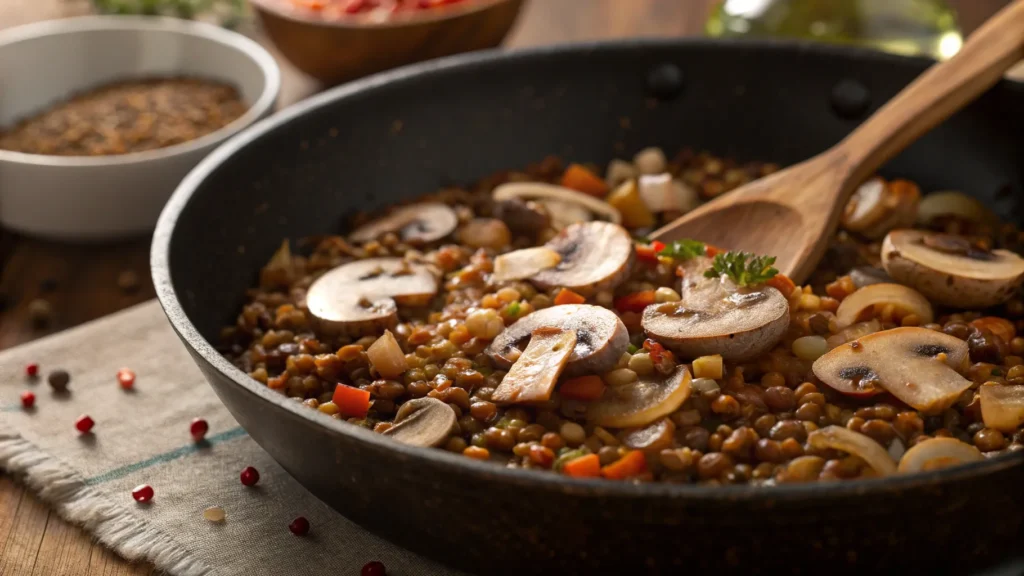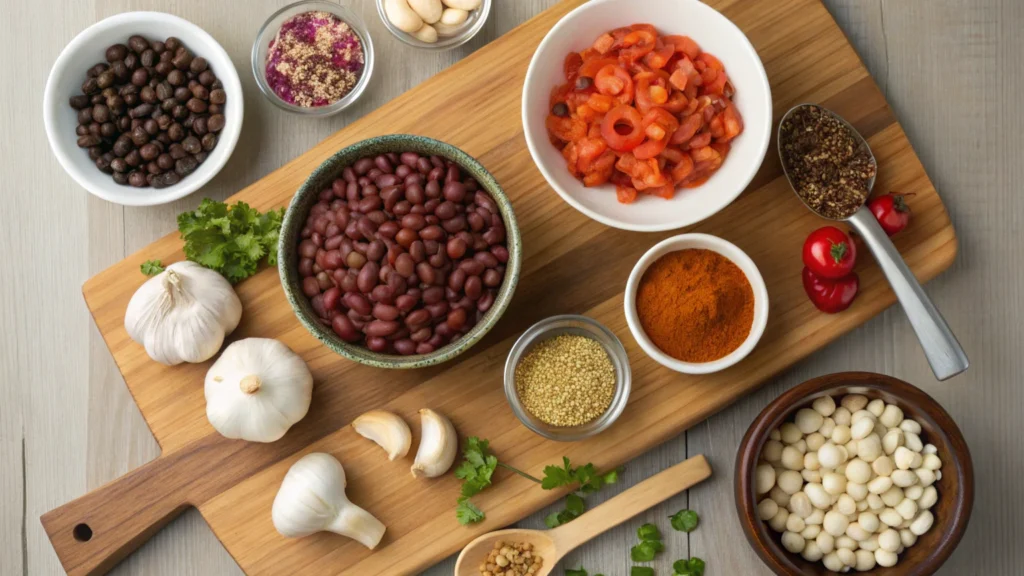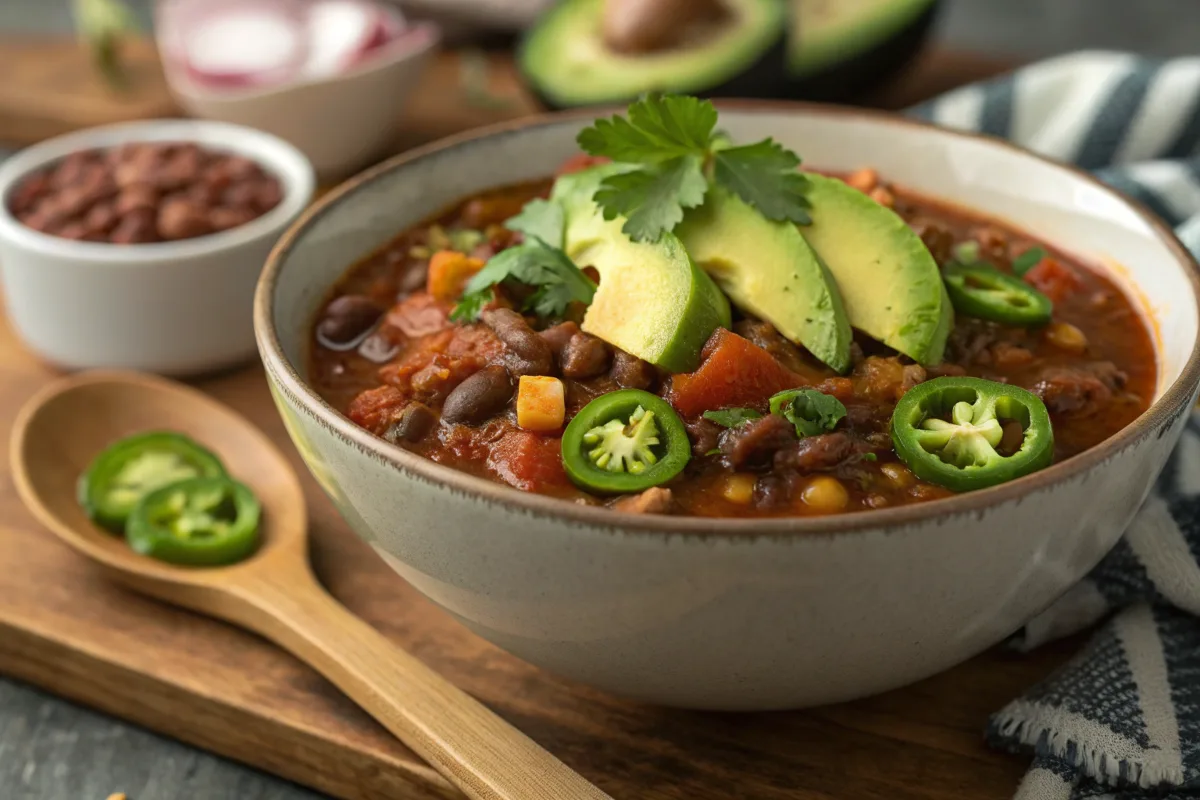The Ultimate Guide to Ground Beef Chili Substitutes for Vegetarians: Tasty Alternatives for a Hearty Dish
Introduction
Ground beef chili substitute vegetarian options are perfect for creating a hearty and flavorful chili without the meat. Whether you’re looking for healthier alternatives, experimenting with plant-based meals, or trying to reduce your environmental footprint, there are countless ways to replace ground beef while maintaining the chili’s rich and satisfying taste. From lentils to mushrooms, this guide covers the best substitutes to make your vegetarian chili a crowd-pleaser.
Learn more about hearty meals in our Ultimate Beef Back Ribs Recipe.
Table of Contents
Why Choose a Vegetarian Substitute for Ground Beef?
Health Benefits of Going Meat-Free
Replacing ground beef with vegetarian alternatives is a healthy choice that comes with several advantages:
- Lower Saturated Fat: Vegetarian substitutes often have less unhealthy fat compared to ground beef.
- High in Fiber: Ingredients like lentils and beans are fiber-rich, aiding digestion.
- Nutrient-Dense: Many substitutes provide vital vitamins and minerals, such as iron, magnesium, and folate.
Environmental Impact
Switching to vegetarian substitutes is an eco-friendly decision. Livestock farming contributes significantly to greenhouse gas emissions, and reducing meat consumption can lower your carbon footprint. Ingredients like lentils, mushrooms, and beans are sustainable and require fewer resources to produce.
A Gateway to Culinary Creativity
Using vegetarian substitutes allows you to experiment with textures and flavors. With so many options available, you’ll never get bored of trying something new.
Top Vegetarian Substitutes for Ground Beef in Chili
When it comes to creating a hearty vegetarian chili, the key is finding substitutes that replicate the texture and flavor of ground beef while adding their unique nutritional benefits. Here are some of the best options:
1. Lentils
Lentils are an excellent ground beef substitute, offering protein, fiber, and essential nutrients. Learn more about their benefits and uses in cooking from The Nutrition Source
- Texture: When cooked, lentils have a soft yet slightly firm texture that mimics ground beef.
- Flavor: They absorb spices and seasonings well, ensuring your chili remains flavorful.
- How to Use: Brown lentils work best. Simply rinse, cook in vegetable broth, and stir into your chili base.
2. Textured Vegetable Protein (TVP)
TVP is a soy-based product that’s a go-to option for vegetarians and vegans.
- Texture: TVP closely resembles ground beef when rehydrated.
- Flavor: Mild on its own, it easily absorbs the chili’s bold spices.
- How to Use: Rehydrate TVP in hot vegetable stock, then sauté with onions and garlic before adding to your chili.
3. Mushrooms
Mushrooms are another excellent substitute, known for their earthy flavor and meaty texture.
- Texture: Finely chopped mushrooms provide a chunky, satisfying bite.
- Flavor: Their umami profile enhances the chili’s depth.
- How to Use: Sauté diced mushrooms with onions and spices before mixing them into the chili.
Properly sautéed mushrooms enhance umami flavors. Pair them with side dishes like French Onion Baked Potatoes for a complete meal.
4. Beans
Beans like black beans, kidney beans, and pinto beans are a classic vegetarian chili staple.
- Texture: Their firm, creamy texture adds substance to the dish.
- Flavor: Beans have a neutral flavor that pairs well with chili seasonings.
- How to Use: Combine a mix of beans for varied texture and taste.
5. Cauliflower or Quinoa
For a creative twist, try cauliflower rice or quinoa.
- Texture: Both add a light, crumbly consistency.
- Flavor: Mild flavors make them versatile.
- How to Use: Lightly steam or cook, then incorporate into the chili for added bulk.
How to Prepare Your Substitutes for Chili
Preparing your vegetarian ground beef substitutes properly is crucial for achieving the right flavor and texture in your chili. Here’s how to get the best out of each substitute:

1. Preparing Lentils
Lentils are easy to cook and incredibly versatile.
- Rinse Thoroughly: Wash the lentils under cold water to remove debris or impurities.
- Cook Until Tender: Simmer lentils in vegetable broth for 15-20 minutes. Avoid overcooking to maintain a firm texture.
- Season While Cooking: Add spices like garlic powder, cumin, and a pinch of salt to enhance their flavor before mixing them into your chili.
2. Rehydrating Textured Vegetable Protein (TVP)
TVP requires a simple rehydration process before it’s ready to use.
- Boil Water or Broth: Use vegetable broth for extra flavor.
- Rehydrate: Pour hot liquid over the TVP and let it sit for 5-10 minutes until it absorbs the liquid.
- Drain and Sauté: Press out any excess liquid, then sauté with onions, garlic, and chili spices for added depth.
3. Sautéing Mushrooms
Properly cooking mushrooms unlocks their full potential.
- Clean and Chop: Wipe mushrooms with a damp cloth and finely dice them for a ground beef-like texture.
- Cook Over Medium Heat: Sauté mushrooms in olive oil or butter with onions and garlic until browned. This enhances their umami flavor.
- Combine with Other Ingredients: Mix mushrooms into the chili base to add richness.
4. Cooking Beans
Beans are a staple for any vegetarian chili.
- Rinse Canned Beans: Remove the starchy liquid by rinsing beans in a colander.
- Soak and Cook Dry Beans: If using dry beans, soak them overnight and cook them until tender.
- Mix for Variety: Combine different types of beans, such as black, kidney, and pinto, for a varied texture.
5. Preparing Quinoa or Cauliflower Rice
These lighter options need minimal prep.
- Quinoa: Rinse and cook in vegetable broth until fluffy.
- Cauliflower Rice: Steam or sauté until tender, then season lightly before adding to your chili.
Spices and Seasonings to Enhance Flavor
A flavorful chili starts with the right combination of spices and seasonings. Vegetarian substitutes often lack the natural umami of meat, but with a carefully chosen spice blend, your chili can be just as robust and savory.

Essential Spices for Chili
These classic spices form the backbone of any chili recipe:
- Chili Powder: The star of the dish, providing a smoky, slightly spicy kick.
- Cumin: Adds a warm, earthy flavor that pairs perfectly with the richness of beans and lentils.
- Paprika: Smoked or sweet paprika enhances the depth of your chili’s flavor.
- Garlic Powder and Onion Powder: Boosts the savory profile of your dish.
- Oregano: Adds a subtle herbaceous note that balances the spiciness.
Spice Ratios for the Perfect Balance
For a pot of chili serving 4-6 people:
- 2 tbsp chili powder
- 1 tbsp cumin
- 1 tsp smoked paprika
- 1 tsp garlic powder
- 1 tsp onion powder
- ½ tsp oregano
Adjust according to your heat tolerance and taste preferences.
Secret Ingredients for Extra Richness
Take your vegetarian chili to the next level with these surprising additions:
- Cocoa Powder: A small pinch of unsweetened cocoa adds a subtle richness and enhances the chili’s depth.
- Dark Chocolate: For a more pronounced effect, melt a square of dark chocolate into the chili.
- Soy Sauce or Liquid Aminos: Adds a savory umami flavor that replicates the taste of meat.
- Apple Cider Vinegar or Lime Juice: A splash of acidity at the end brightens the flavors.
Layering Spices for Maximum Impact
To make your chili flavorful from start to finish:
- Toast Your Spices: Sauté them with onions and garlic at the beginning to enhance their aroma.
- Add in Layers: Include some spices early in the cooking process and save the rest for the final 10 minutes of simmering.
- Taste and Adjust: Season gradually, tasting as you go to ensure a balanced flavor.
Fresh Herbs and Garnishes
Complete your chili with fresh toppings:
- Cilantro: Adds brightness and color.
- Green Onions: Offers a sharp, fresh flavor.
- Jalapeños: For a spicy kick.
Common Mistakes to Avoid with Vegetarian Chili
Making vegetarian chili is a delicious endeavor, but there are a few common mistakes that can prevent it from reaching its full potential. Here’s what to watch out for and how to fix it.
1. Not Properly Seasoning Your Chili
Vegetarian substitutes like lentils, TVP, and mushrooms don’t naturally have the umami flavor that ground beef provides.
- Fix: Use bold spices and seasonings, like chili powder, cumin, smoked paprika, and soy sauce. Incorporate umami-rich ingredients like tomato paste or nutritional yeast for added depth.
2. Overcooking or Undercooking Ingredients
Timing is everything in chili! Overcooking lentils or mushrooms can result in a mushy texture, while undercooked beans or vegetables can feel hard and unpleasant.
- Fix: Follow proper cooking times for each ingredient. Cook lentils until tender but firm, and add mushrooms in the middle of the cooking process to preserve their texture.
Properly cooked beans are key to a great chili. For more cooking tips, check out our Ground Beef Cabbage Recipe.
3. Skipping the Sautéing Step
Throwing raw aromatics (like onions and garlic) and spices directly into the pot without sautéing can leave your chili lacking in depth.
- Fix: Sauté onions, garlic, and spices in oil before adding the remaining ingredients. This step releases the flavors and enhances the dish.
4. Using Too Much Liquid
Vegetarian substitutes like lentils and beans don’t absorb liquid the same way meat does, which can make your chili too soupy.
- Fix: Start with less liquid and add more as needed. Simmer uncovered to reduce excess liquid and achieve the desired consistency.
5. Not Letting the Chili Simmer
Rushing the cooking process can prevent the flavors from fully developing.
- Fix: Allow your chili to simmer for at least 30-45 minutes, stirring occasionally to blend the flavors.
Avoiding these mistakes will ensure your vegetarian chili turns out perfectly hearty, flavorful, and satisfying every time!
Advanced Tips and Tricks for Vegetarian Chili
Ready to take your vegetarian chili to the next level? These advanced tips and tricks will help you enhance the flavor, texture, and presentation of your dish. Whether you’re cooking for a family dinner or a potluck, these ideas will make your chili unforgettable.
1. Combine Multiple Protein Sources
For a hearty and satisfying texture, use a mix of vegetarian proteins:
- Lentils and TVP: This combo gives a balance of firmness and meat-like crumble.
- Beans and Quinoa: A mix of black beans, kidney beans, and cooked quinoa adds protein and a variety of textures.
- Mushrooms and Walnuts: Finely diced mushrooms with crushed walnuts create a rich, meaty texture with added crunch.
2. Experiment with Spice Blends
Go beyond the basics to give your chili a unique twist:
- Mexican-Inspired: Add chipotle powder, cinnamon, and a touch of cocoa for a smoky, sweet, and spicy flavor.
- Indian-Inspired: Use garam masala, turmeric, and coriander for a warming, aromatic chili.
- Mediterranean-Inspired: Incorporate smoked paprika, fennel seeds, and thyme for a savory, herbaceous kick.
3. Layer Your Ingredients
Cooking chili in layers allows each component to develop its flavor:
- Aromatics First: Sauté onions, garlic, and bell peppers in olive oil.
- Add the Spices: Toast your spices in the oil to release their fragrance.
- Build the Base: Stir in tomato paste, crushed tomatoes, and vegetable broth for a rich foundation.
- Simmer the Proteins: Add your chosen substitutes (lentils, beans, mushrooms, etc.) and let them absorb the flavors.
4. Use Flavor Boosters
Add depth and complexity to your chili with these ingredients:
- Umami Additions: Soy sauce, miso paste, or nutritional yeast.
- Sweet Balancers: A touch of maple syrup, molasses, or brown sugar.
- Acidic Finish: Lime juice, apple cider vinegar, or balsamic vinegar at the end of cooking.
5. Garnish Like a Pro
Elevate your chili’s presentation and flavor with these toppings:
- Creamy Elements: Avocado slices, sour cream, or a dollop of vegan yogurt.
- Crunchy Additions: Crushed tortilla chips, toasted pumpkin seeds, or crispy onions.
- Fresh Flavors: Cilantro, diced red onions, or thinly sliced jalapeños.
How to Track and Measure Your Success with Vegetarian Chili
Cooking a delicious vegetarian chili isn’t just about following a recipe—it’s about refining your process to achieve the perfect balance of flavors and textures. Tracking and measuring your success allows you to improve with each batch. Here’s how to do it effectively.

1. Gathering Feedback from Tasters
If you’re cooking for family, friends, or guests, their feedback is invaluable.
- Ask Specific Questions:
- “Is the texture hearty enough?”
- “Are the flavors well-balanced or too spicy?”
- “What toppings would enhance the dish?”
- Encourage Honest Reviews: Constructive criticism will help you refine the recipe.
2. Keeping a Chili Journal
Track each batch you make to identify what works and what needs adjustment.
- Document Ingredients and Quantities: Note the exact substitutes, spices, and toppings you used.
- Record Cooking Times: Keep track of how long you simmered and whether it impacted the consistency.
- Rate Each Batch: Use a scale of 1-10 for categories like flavor, texture, and overall satisfaction.
3. Using Visual Cues
Pay attention to how your chili looks during each step of cooking.
- Texture: Is the chili thick and chunky or too watery?
- Color: A rich, vibrant red-orange hue typically indicates a well-seasoned chili.
4. Evaluating Nutritional Success
Measure the health benefits of your vegetarian chili:
- Nutritional Value: Use an app or online tool to calculate protein, fiber, and calorie content.
- Satiation: Note whether the chili keeps you or your tasters full and satisfied.
5. Hosting a Chili Cook-Off
Invite friends to make their versions of vegetarian chili and compare:
- Taste Testing: Try different recipes side-by-side.
- Learning New Techniques: Discover new substitutes, spices, or garnishes from others.
Tracking your progress helps you perfect your vegetarian chili recipe, ensuring it becomes a household favorite!
The Role of Vegetarian Chili in Healthy Eating
Vegetarian chili isn’t just a delicious comfort food—it’s also a powerhouse of nutrition that fits perfectly into a healthy eating lifestyle. Packed with plant-based proteins, fiber, and essential nutrients, this meat-free dish offers a balance of flavor and health benefits that make it a staple for anyone looking to eat well. Balance your meals with side dishes like our French Onion Baked Potatoes.
1. Nutritional Benefits of Vegetarian Chili
- Rich in Protein
Lentils, beans, and textured vegetable protein (TVP) provide ample protein, making vegetarian chili a satisfying meal that helps maintain muscle and energy levels.- Example: A single serving of lentil-based chili can provide up to 18g of protein.
- High Fiber Content
Ingredients like black beans, kidney beans, and vegetables are fiber-rich, promoting healthy digestion and keeping you full longer.- Fiber also supports heart health by lowering cholesterol levels.
- Packed with Vitamins and Minerals
Vegetarian chili is brimming with essential nutrients:- Iron: From lentils and spinach, supports red blood cell production.
- Magnesium: Found in beans, promotes bone health and energy production.
- Vitamin C: From tomatoes and peppers, boosts immunity.
2. Perfect for Weight Management
Vegetarian chili is naturally low in calories when compared to its meat-based counterpart.
- Low Fat: Using plant-based ingredients reduces unhealthy saturated fats.
- Portion Control: The fiber and protein combo keeps you satiated, reducing the likelihood of overeating.
3. A Versatile Meal for All Diets
- Gluten-Free: By choosing gluten-free ingredients, vegetarian chili can fit into a celiac-friendly diet.
- Vegan-Friendly: Avoiding dairy-based toppings keeps the chili 100% plant-based.
- Customizable: Adjust spices, proteins, and vegetables to cater to specific dietary needs.
By incorporating vegetarian chili into your meal plan, you’re treating yourself to a dish that’s as nutritious as it is delicious.
FAQs About Vegetarian Substitutes for Ground Beef
Curious about making the perfect vegetarian chili? Here are answers to some of the most commonly asked questions about ground beef substitutes and how to make your chili shine.
1. Can I use beans instead of ground beef in chili?
Absolutely! Beans like black beans, kidney beans, and pinto beans are classic and hearty options. They’re rich in protein, fiber, and have a creamy texture that complements chili beautifully.
2. What is the best substitute for ground beef in vegetarian chili?
The best substitute depends on your preference:
- Lentils: For a soft, meaty texture.
- Textured Vegetable Protein (TVP): For a crumbly, ground-beef-like consistency.
- Mushrooms: For a rich, earthy flavor.
3. How do I add more flavor to vegetarian chili?
Vegetarian chili benefits from bold seasoning. Use spices like cumin, chili powder, smoked paprika, and oregano. Umami boosters like soy sauce, nutritional yeast, or a splash of vinegar can also enhance the depth of flavor.
4. Is vegetarian chili healthy?
Yes! Vegetarian chili is nutrient-dense, low in saturated fat, and high in fiber, making it a heart-healthy and filling option.
5. Can I make vegetarian chili gluten-free?
Certainly! Use gluten-free soy sauce and avoid any processed substitutes containing gluten, like some brands of TVP. Always check labels to ensure your ingredients are gluten-free.
6. Can I freeze vegetarian chili?
Yes, vegetarian chili freezes well. Let it cool completely before transferring it to airtight containers. It can last up to 3 months in the freezer.
These answers will help you make the most of your vegetarian chili and tailor it to your taste and dietary needs!
Conclusion and Final Thoughts
Switching to vegetarian substitutes for ground beef in chili doesn’t mean sacrificing flavor or heartiness. With options like lentils, textured vegetable protein (TVP), mushrooms, and beans, you can create a dish that’s rich, satisfying, and packed with nutrients.
As we’ve explored, the key to a great vegetarian chili lies in the details:
- Choose the Right Substitutes: Pick ingredients that mimic the texture of ground beef while enhancing the chili’s flavor.
- Season Generously: Bold spices and umami boosters ensure your dish is anything but bland.
- Experiment and Customize: Mix and match ingredients like beans, quinoa, or mushrooms to create a chili that suits your taste and dietary needs.
Whether you’re cooking for Meatless Monday, feeding a crowd, or looking for a healthier alternative, vegetarian chili is a versatile dish that adapts beautifully to any occasion. It’s sustainable, nutritious, and deeply comforting—perfect for cozy nights or quick meal preps.
So, grab your pot and get creative in the kitchen. Your next bowl of chili might just be the best you’ve ever made!

